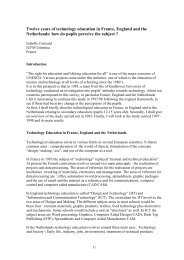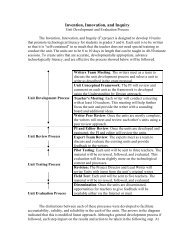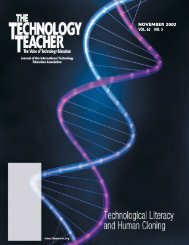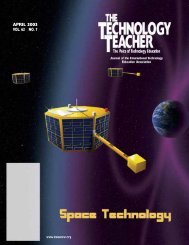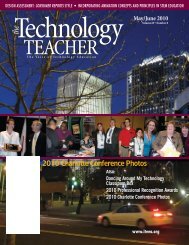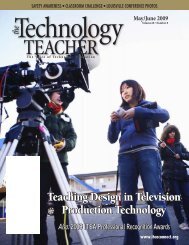October 2004 - Vol 64, No.2 - International Technology and ...
October 2004 - Vol 64, No.2 - International Technology and ...
October 2004 - Vol 64, No.2 - International Technology and ...
- No tags were found...
Create successful ePaper yourself
Turn your PDF publications into a flip-book with our unique Google optimized e-Paper software.
RESOURCES IN TECHNOLOGYFigure 1 shows the top ten countriesutilizing nuclear power for theirelectrical needs. Nuclear power ismostly utilized in industrializedcountries, which have the necessarytechnological, institutional, <strong>and</strong> financialresources. Only 39 of the world’s440 nuclear power plants are in developingcountries, <strong>and</strong> because they aresmaller than average, they account foronly 5.6 percent of the world’s nuclearpower capacity (NEI, <strong>2004</strong>). Today,a growing dem<strong>and</strong> for affordable,reliable, <strong>and</strong> emission-free electricityis renewing worldwide interest innuclear energy.A Global NeedAccording to U. S. Census Bureauestimates, world population hit the sixbillion mark in June 1999. This figureis over 3.5 times the size of theearth’s population at the beginning ofthe twentieth century <strong>and</strong> roughlydouble its size in 1960. During thenext 50 years, a surge in global populationfrom six billion to nine billion willoccur, mainly in nations on the ladderof economic development. (See Figure2). During this period, humanity willconsume more energy than the combinedtotal used in all previous history.Figure 2. The world population willincrease over 3.5 times from 1950through projections for the year 2050according to the U. S. Census Bureau.During this period, humans will need <strong>and</strong>consume significantly more energy thanthe combined total used in previoushistory. (U. S. Census Bureau)Of all energy sources, nuclear energyhas perhaps the lowest impact on theenvironment, including water, l<strong>and</strong>,habitat, species, <strong>and</strong> air resources.Nuclear energy is the most ecologicallyefficient of all energy sourcesbecause it produces the mostelectricity in relation to its minimalenvironmental impact. Nuclear energyis the world’s largest source of emission-freeenergy. Electricity producedby nuclear power results in almostnone of the greenhouse <strong>and</strong> acid gasemissions associated with fossil fuelfiredplants. Nuclear power plants producevirtually no sulfur dioxide,particulates, nitrogen oxides, volatileorganic compounds, or greenhousegases. The complete nuclear powerchain, from resource extraction towaste disposal, including reactor <strong>and</strong>facility construction, emits only asmall amount of carbon, about thesame as wind <strong>and</strong> solar power,including construction <strong>and</strong> componentmanufacturing.Globally, nuclear power currentlyavoids approximately 600 milliontons of carbon emissions annually,about the same as hydropower(IAEA, <strong>2004</strong>). The Director General ofthe <strong>International</strong> Atomic EnergyAgency, Dr. Mohamed ElBaradei, saidin advance of a gathering of 500nuclear power experts assembled inMoscow for the “<strong>International</strong>Conference on Fifty Years of NuclearPower—the Next Fifty Years”(June 27-July 2, <strong>2004</strong>), “The more welook to the future, the more we canexpect countries to be considering thepotential benefits that exp<strong>and</strong>ingnuclear power has to offer for theglobal environment <strong>and</strong> for economicgrowth.” Dr. ElBaradei added, “Thedecision to adopt nuclear power cannotbe made on a “one-size-fits-all”basis. New nuclear plants are mostattractive where energy dem<strong>and</strong> isgrowing <strong>and</strong> alternative resources arescarce, <strong>and</strong> where energy security<strong>and</strong> reduced air pollution <strong>and</strong> greenhousegases are a priority.” In orderfor nuclear energy to play a meaningfulrole in the global energy supply,innovative approaches will be requiredto address concerns about economiccompetitiveness, safety, waste, <strong>and</strong>potential proliferation risks (Perera,<strong>2004</strong>).A Global ResourceMajor developing nations, such asChina <strong>and</strong> India, have joined countrieslike France, Japan, Russia, <strong>and</strong> theUnited States in recognizing that anystrategy for a clean-energy futurerequires nuclear energy. Nations representingfully half the world’s peopleare now constructing new nuclearpower plants, <strong>and</strong> countries withoutnuclear power have begun to plan forit, seeking reliability, clean air, <strong>and</strong>energy independence. Nuclear poweris the only proven option that can generateprimary energy cleanly, on thevastly increased scale required tomeet global dem<strong>and</strong> (IAEA, <strong>2004</strong>).Nuclear Power—Pros <strong>and</strong>ConsThere are many disputes that ariseover the use of nuclear power.Deciding about future energy developmentsrequires balanced <strong>and</strong> trustworthyinformation about issues such asthe relative environmental effects ofdifferent options, the safety of installations,economics, <strong>and</strong> the availabilityof resources. These decisions take onan added importance now becauseworld energy use is expected to growsignificantly over the next fifty years,<strong>and</strong> the reality is that global emissionsof greenhouse gases will have to bedrastically cut (Beck, <strong>2004</strong>). Nuclearopponents stress the absence of highlevelradioactive waste disposalfacilities, the high risk of nuclearweapons proliferation, <strong>and</strong> the beliefthat nuclear power will never be sufficientlysafe to be part of sustainable22 <strong>October</strong> <strong>2004</strong> • THE TECHNOLOGY TEACHER



